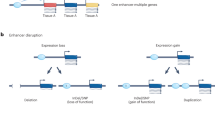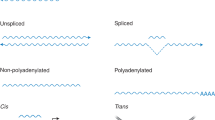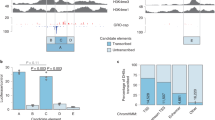Abstract
In contrast to protein-coding sequences, the significance of variation in non-coding DNA in human disease has been minimally explored. A great number of recent genome-wide association studies suggest that non-coding variation is a significant risk factor for common disorders, but the mechanisms by which this variation contributes to disease remain largely obscure. Distant-acting transcriptional enhancers — a major category of functional non-coding DNA — are involved in many developmental and disease-relevant processes. Genome-wide approaches to their discovery and functional characterization are now available and provide a growing knowledge base for the systematic exploration of their role in human biology and disease susceptibility.
This is a preview of subscription content, access via your institution
Access options
Subscribe to this journal
Receive 51 print issues and online access
$199.00 per year
only $3.90 per issue
Buy this article
- Purchase on Springer Link
- Instant access to full article PDF
Prices may be subject to local taxes which are calculated during checkout


Similar content being viewed by others
References
Mouse Genome Sequencing Consortium. Initial sequencing and comparative analysis of the mouse genome. Nature 420, 520–562 (2002).
Siepel, A. et al. Evolutionarily conserved elements in vertebrate, insect, worm, and yeast genomes. Genome Res. 15, 1034–1050 (2005).
Helgadottir, A. et al. A common variant on chromosome 9p21 affects the risk of myocardial infarction. Science 316, 1491–1493 (2007).
McPherson, R. et al. A common allele on chromosome 9 associated with coronary heart disease. Science 316, 1488–1491 (2007).
Hindorff, L. A., Junkins, H. A., Mehta, J. P. & Manolio, T. A. A catalog of published genome-wide association studies. OPG: Catalog Published Genome-Wide Assoc. Studies <http://www.genome.gov/gwastudies> (2009).
Maston, G. A., Evans, S. K. & Green, M. R. Transcriptional regulatory elements in the human genome. Annu. Rev. Genomics Hum. Genet. 7, 29–59 (2006). This paper is a comprehensive overview of functional classes of gene regulatory sequence, including many disease-relevant examples identified through gene-centric studies.
Banerji, J., Rusconi, S. & Schaffner, W. Expression of a β-globin gene is enhanced by remote SV40 DNA sequences. Cell 27, 299–308 (1981).
Panne, D. The enhanceosome. Curr. Opin. Struct. Biol. 18, 236–242 (2008).
Visel, A., Bristow, J. & Pennacchio, L. A. Enhancer identification through comparative genomics. Semin. Cell Dev. Biol. 18, 140–152 (2007).
Visel, A. et al. Functional autonomy of distant-acting human enhancers. Genomics 93, 509–513 (2009).
Ingram, V. M. Gene mutations in human haemoglobin: the chemical difference between normal and sickle cell haemoglobin. Nature 180, 326–328 (1957).
Pauling, L. et al. Sickle cell anemia, a molecular disease. Science 110, 543–548 (1949).
Kan, Y. W. et al. Deletion of α-globin genes in haemoglobin-H disease demonstrates multiple α-globin structural loci. Nature 255, 255–256 (1975).
Kioussis, D., Vanin, E., deLange, T., Flavell, R. A. & Grosveld, F. G. β-Globin gene inactivation by DNA translocation in γβ-thalassaemia. Nature 306, 662–666 (1983).
Semenza, G. L. et al. The silent carrier allele: β thalassemia without a mutation in the β-globin gene or its immediate flanking regions. Cell 39, 123–128 (1984).
Kleinjan, D. A. & Lettice, L. A. Long-range gene control and genetic disease. Adv. Genet. 61, 339–388 (2008).
Sagai, T., Hosoya, M., Mizushina, Y., Tamura, M. & Shiroishi, T. Elimination of a long-range cis-regulatory module causes complete loss of limb-specific Shh expression and truncation of the mouse limb. Development 132, 797–803 (2005). This paper shows that deletion of the distant-acting limb enhancer of the Shh gene in mice causes severe limb truncation, providing a model example of the requirement for enhancers in mammalian development.
Lettice, L. A. et al. A long-range Shh enhancer regulates expression in the developing limb and fin and is associated with preaxial polydactyly. Hum. Mol. Genet. 12, 1725–1735 (2003).
Clark, R. M., Marker, P. C. & Kingsley, D. M. A novel candidate gene for mouse and human preaxial polydactyly with altered expression in limbs of Hemimelic extra-toes mutant mice. Genomics 67, 19–27 (2000).
Furniss, D. et al. A variant in the sonic hedgehog regulatory sequence (ZRS) is associated with triphalangeal thumb and deregulates expression in the developing limb. Hum. Mol. Genet. 17, 2417–2423 (2008).
Masuya, H. et al. A series of ENU-induced single-base substitutions in a long-range cis-element altering Sonic hedgehog expression in the developing mouse limb bud. Genomics 89, 207–214 (2007).
Lettice, L. A., Hill, A. E., Devenney, P. S. & Hill, R. E. Point mutations in a distant sonic hedgehog cis-regulator generate a variable regulatory output responsible for preaxial polydactyly. Hum. Mol. Genet. 17, 978–985 (2008).
Lettice, L. A. et al. Disruption of a long-range cis-acting regulator for Shh causes preaxial polydactyly. Proc. Natl Acad. Sci. USA 99, 7548–7553 (2002).
Bolk, S. et al. A human model for multigenic inheritance: phenotypic expression in Hirschsprung disease requires both the RET gene and a new 9q31 locus. Proc. Natl Acad. Sci. USA 97, 268–273 (2000).
Gabriel, S. B. et al. Segregation at three loci explains familial and population risk in Hirschsprung disease. Nature Genet. 31, 89–93 (2002).
Emison, E. S. et al. A common sex-dependent mutation in a RET enhancer underlies Hirschsprung disease risk. Nature 434, 857–863 (2005).
Grice, E. A., Rochelle, E. S., Green, E. D., Chakravarti, A. & McCallion, A. S. Evaluation of the RET regulatory landscape reveals the biological relevance of a HSCR-implicated enhancer. Hum. Mol. Genet. 14, 3837–3845 (2005).
Cookson, W., Liang, L., Abecasis, G., Moffatt, M. & Lathrop, M. Mapping complex disease traits with global gene expression. Nature Rev. Genet. 10, 184–194 (2009).
Aparicio, S. et al. Detecting conserved regulatory elements with the model genome of the Japanese puffer fish, Fugu rubripes . Proc. Natl Acad. Sci. USA 92, 1684–1688 (1995).
Loots, G. G. et al. Identification of a coordinate regulator of interleukins 4, 13 and 5 by cross-species sequence comparisons. Science 288, 136–140 (2000).
Nobrega, M. A., Ovcharenko, I., Afzal, V. & Rubin, E. M. Scanning human gene deserts for long-range enhancers. Science 302, 413 (2003).
Pennacchio, L. A. et al. In vivo enhancer analysis of human conserved non-coding sequences. Nature 444, 499–502 (2006).
Visel, A. et al. Ultraconservation identifies a small subset of extremely constrained developmental enhancers. Nature Genet. 40, 158–160 (2008).
Woolfe, A. et al. Highly conserved non-coding sequences are associated with vertebrate development. PLoS Biol. 3, e7 (2005).
Bejerano, G. et al. Ultraconserved elements in the human genome. Science 304, 1321–1325 (2004).
Prabhakar, S. et al. Close sequence comparisons are sufficient to identify human cis-regulatory elements. Genome Res. 16, 855–863 (2006).
Cooper, G. M. et al. Distribution and intensity of constraint in mammalian genomic sequence. Genome Res. 15, 901–913 (2005).
Ahituv, N. et al. Deletion of ultraconserved elements yields viable mice. PLoS Biol. 5, e234 (2007). This paper shows that deletion of several ultraconserved non-coding sequences in mice may not result in obvious phenotypes, demonstrating that even extreme evolutionary constraint does not necessarily indicate that a non-coding sequence is required for viability.
The ENCODE Project Consortium. Identification and analysis of functional elements in 1% of the human genome by the ENCODE pilot project. Nature 447, 799–816 (2007).
Heintzman, N. D. et al. Distinct and predictive chromatin signatures of transcriptional promoters and enhancers in the human genome. Nature Genet. 39, 311–318 (2007). This paper identifies a histone H3K4 differential methylation signature that distinguishes promoters from enhancers, providing a chromatin-based tool for genome-wide enhancer prediction.
Heintzman, N. D. et al. Histone modifications at human enhancers reflect global cell-type-specific gene expression. Nature 459, 108–112 (2009).
Xi, H. et al. Identification and characterization of cell type-specific and ubiquitous chromatin regulatory structures in the human genome. PLoS Genet. 3, e136 (2007).
Wei, C. L. et al. A global map of p53 transcription-factor binding sites in the human genome. Cell 124, 207–219 (2006). This paper describes mapping of protein–DNA interactions by ChIP coupled with conventional capillary-based sequencing of concatenated paired-end tags (ChIP-PET), a conceptual predecessor of the ChIP-seq approach.
Barski, A. et al. High-resolution profiling of histone methylations in the human genome. Cell 129, 823–837 (2007).
Johnson, D. S., Mortazavi, A., Myers, R. M. & Wold, B. Genome-wide mapping of in vivo protein–DNA interactions. Science 316, 1497–1502 (2007).
Robertson, G. et al. Genome-wide profiles of STAT1 DNA association using chromatin immunoprecipitation and massively parallel sequencing. Nature Methods 4, 651–657 (2007). This paper is one of several independently published early ChIP-seq studies validating the method for genome-wide mapping of transcription-factor-binding sites.
Mikkelsen, T. S. et al. Genome-wide maps of chromatin state in pluripotent and lineage-committed cells. Nature 448, 553–560 (2007). This paper is one of several independently published early ChIP-seq studies providing some of the first genome-wide data sets of several histone modifications in different mouse cell types and examining their correlation with functional genome features.
Zhao, X. D. et al. Whole-genome mapping of histone H3 Lys4 and 27 trimethylations reveals distinct genomic compartments in human embryonic stem cells. Cell Stem Cell 1, 286–298 (2007).
Chen, X. et al. Integration of external signaling pathways with the core transcriptional network in embryonic stem cells. Cell 133, 1106–1117 (2008).
Wederell, E. D. et al. Global analysis of in vivo Foxa2-binding sites in mouse adult liver using massively parallel sequencing. Nucleic Acids Res. 36, 4549–4564 (2008).
Robertson, A. G. et al. Genome-wide relationship between histone H3 lysine 4 mono- and tri-methylation and transcription factor binding. Genome Res. 18, 1906–1917 (2008).
Ku, M. et al. Genomewide analysis of PRC1 and PRC2 occupancy identifies two classes of bivalent domains. PLoS Genet. 4, e1000242 (2008).
Cuddapah, S. et al. Global analysis of the insulator binding protein CTCF in chromatin barrier regions reveals demarcation of active and repressive domains. Genome Res. 19, 24–32 (2009).
Gao, N. et al. Dynamic regulation of Pdx1 enhancers by Foxa1 and Foxa2 is essential for pancreas development. Genes Dev. 22, 3435–3448 (2008).
Wang, Z. et al. Combinatorial patterns of histone acetylations and methylations in the human genome. Nature Genet. 40, 897–903 (2008).
Visel, A. et al. ChIP-seq accurately predicts tissue-specific activity of enhancers. Nature 457, 854–858 (2009).
Cooper, G. M. & Brown, C. D. Qualifying the relationship between sequence conservation and molecular function. Genome Res. 18, 201–205 (2008).
McGaughey, D. M. et al. Metrics of sequence constraint overlook regulatory sequences in an exhaustive analysis at phox2b . Genome Res. 18, 252–260 (2008).
Bernstein, B. E. et al. Genomic maps and comparative analysis of histone modifications in human and mouse. Cell 120, 169–181 (2005).
Wang, Z., Gerstein, M. & Snyder, M. RNA-Seq: a revolutionary tool for transcriptomics. Nature Rev. Genet. 10, 57–63 (2009).
Dekker, J., Rippe, K., Dekker, M. & Kleckner, N. Capturing chromosome conformation. Science 295, 1306–1311 (2002).
Amano, T. et al. Chromosomal dynamics at the Shh locus: limb bud-specific differential regulation of competence and active transcription. Dev. Cell 16, 47–57 (2009).
Carter, D., Chakalova, L., Osborne, C. S., Dai, Y. F. & Fraser, P. Long-range chromatin regulatory interactions in vivo . Nature Genet. 32, 623–626 (2002).
Fullwood, M. J., Wei, C. L., Liu, E. T. & Ruan, Y. Next-generation DNA sequencing of paired-end tags (PET) for transcriptome and genome analyses. Genome Res. 19, 521–532 (2009).
Miele, A. & Dekker, J. Long-range chromosomal interactions and gene regulation. Mol. Biosyst. 4, 1046–1057 (2008).
Simonis, M. et al. Nuclear organization of active and inactive chromatin domains uncovered by chromosome conformation capture-on-chip (4C). Nature Genet. 38, 1348–1354 (2006).
Zhao, Z. et al. Circular chromosome conformation capture (4C) uncovers extensive networks of epigenetically regulated intra- and interchromosomal interactions. Nature Genet. 38, 1341–1347 (2006).
Dostie, J. et al. Chromosome conformation capture carbon copy (5C): a massively parallel solution for mapping interactions between genomic elements. Genome Res. 16, 1299–1309 (2006).
Lee, T. I. et al. Control of developmental regulators by Polycomb in human embryonic stem cells. Cell 125, 301–313 (2006).
Squazzo, S. L. et al. Suz12 binds to silenced regions of the genome in a cell-type-specific manner. Genome Res. 16, 890–900 (2006).
Van Lente, F., Jackson, J. F. & Weintraub, H. Identification of specific crosslinked histones after treatment of chromatin with formaldehyde. Cell 5, 45–50 (1975).
Solomon, M. J., Larsen, P. L. & Varshavsky, A. Mapping protein–DNA interactions in vivo with formaldehyde: evidence that histone H4 is retained on a highly transcribed gene. Cell 53, 937–947 (1988).
Ren, B. et al. Genome-wide location and function of DNA binding proteins. Science 290, 2306–2309 (2000).
Iyer, V. R. et al. Genomic binding sites of the yeast cell-cycle transcription factors SBF and MBF. Nature 409, 533–538 (2001).
Horak, C. E. et al. GATA-1 binding sites mapped in the β-globin locus by using mammalian chIp-chip analysis. Proc. Natl Acad. Sci. USA 99, 2924–2929 (2002).
Barski, A. & Zhao, K. Genomic location analysis by ChIP-seq. J. Cell. Biochem. 107, 11–18 (2009).
Acknowledgements
We thank M. Blow, S. Deutsch and A. Sczyrba for help with computational analysis of GWAS data and C. Attanasio for comments. L.A.P. and E.M.R. were supported by the Berkeley Program for Genomic Applications (funded by the US National Heart, Lung, and Blood Institute), and the Director, Office of Science, Office of Basic Energy Sciences, US Department of Energy, under contract number DE-AC02-05CH11231. L.A.P. was also supported by the US National Human Genome Research Institute.
Author information
Authors and Affiliations
Ethics declarations
Competing interests
The authors declare no competing financial interests.
Additional information
Reprints and permissions information is available at http://www.nature.com/reprints.
Correspondence should be addressed to L.A.P. (lapennacchio@lbl.gov).
Rights and permissions
About this article
Cite this article
Visel, A., Rubin, E. & Pennacchio, L. Genomic views of distant-acting enhancers. Nature 461, 199–205 (2009). https://doi.org/10.1038/nature08451
Published:
Issue Date:
DOI: https://doi.org/10.1038/nature08451
This article is cited by
-
Affinity-optimizing enhancer variants disrupt development
Nature (2024)
-
Current advances in primate genomics: novel approaches for understanding evolution and disease
Nature Reviews Genetics (2023)
-
Recent advances in chromosome capture techniques unraveling 3D genome architecture in germ cells, health, and disease
Functional & Integrative Genomics (2023)
-
Molecular characterization of Richter syndrome identifies de novo diffuse large B-cell lymphomas with poor prognosis
Nature Communications (2023)
-
StackEPI: identification of cell line-specific enhancer–promoter interactions based on stacking ensemble learning
BMC Bioinformatics (2022)
Comments
By submitting a comment you agree to abide by our Terms and Community Guidelines. If you find something abusive or that does not comply with our terms or guidelines please flag it as inappropriate.



